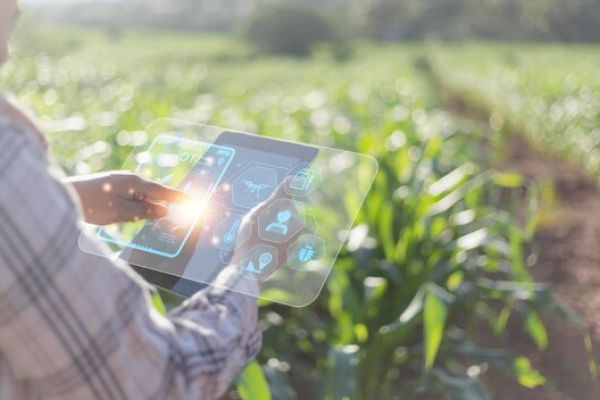Agricultural Advancements: The Role of Modern Farming Technologies

In India’s economy, agriculture plays a significant role, employing a large portion of the workforce. One of the most notable representatives of innovation use is the agriculture sphere. However, the sector faces various hurdles, including unpredictable weather patterns and the need to increase productivity. To address these hurdles, implementing modern farming technologies and innovative approaches has become prominent. Indeed, robots, drones, and other great machines are implemented in the farming sector, and we can see excellent results of the lot in agriculture. This article looks at its uses and impact on improving productivity and sustainability. Additionally, the availability of these cutting-edge technologies is further facilitated by the rise of online agriculture shops, providing farmers easy access to the latest tools and equipment.
GIS - Based Technology in Agriculture
The advent of Geographic Information System (GIS) technology in agriculture has witnessed a remarkable transformation. GIS-based agriculture, precision agriculture, is evolving how farmers approach their work. Farmers can make informed decisions, reduce environmental impact, and increase productivity by employing advanced plotting and geographical analysis techniques. It fetches them to GIS software, a geographic information system. It is a modern farming technology that can portray current and future modifications in soil condition, plant health, precipitation temperature, and other helpful information for a good harvest. By uniting these different data sources, farmers can earn valuable insights into crop health, water management, and soil conditions. This permits them to make data-driven decisions, optimize resource allotment, and minimize waste. With GIS, farmers can precisely identify areas that require extra fertilization, irrigation, or pest control, leading to more proficient farming practices and higher yields.
In addition, the use of drones equipped with GIS technology is becoming more dominant. Drones can capture high-resolution imagery of fields, providing valuable data for analysis and transparent farming practices. These revolutions and ongoing research and development will continue to drive the adoption and evolution of GIS-based technology in agriculture.
Livestock Farming Technology in Agriculture
Modern farming technologies have evolved the agricultural landscape, and livestock farming is no exception. Nowadays, advancements in livestock farming technology have played a key role in boosting this vital sector's efficiency, viability, and productivity.
Precision Livestock Farming (PLF):
Precision Livestock Farming is a technology-driven tactic that uses data and sensors to oversee and manage individual animals' well-being, health, and productivity. This system employs various sensors, containing GPS, RFID, and wearable devices, to collect real-time data on attributes like feed intake, body temperature, and behavior. Farmers can use this information to make proficient decisions, detect health issues early, and optimize feeding practices. It improves animal welfare and leads to more efficient resource utilization and higher yields.
Sustainable Animal Nutrition
With specialized diets designed to meet the specific needs of animals at varied stages of their growth, livestock nutrition has seen notable progress. This technology enhances feed conversion, reduces environmental marks, and refines animal health. Experts are also examining alternative protein sources to reduce reliance on traditional feedstocks like corn and soy, insect-based feeds.
Genetic Selection and Breeding
Modern Genetic techniques, containing genomics and artificial fertilization, have transformed the breeding process. Farmers can now opt for animals with appealing traits, such as high meat or milk production, disease resistance, and refined feed efficiency. This not only enlarges livestock productivity but also reduces the need for antibiotics and other medicinal interventions.
Animal Health And Welfare
Livestock Farming Technology takes in the use of wearable devices and sensors to constantly oversee animal health and welfare. This permits primitive disorder spotting and intervention, enriching the well- being of animals and assuring the produce of better- trained and good food products.
Environmental Sustainability
Livestock agriculture technology plays a vital job in boosting environmental sustainability. Waste-to-energy conversion, reduced greenhouse gas emissions, and innovations in manure management contribute to easing the environmental impact of livestock farming.
Sattelite-Derived Data
Satellite-derived data plays a crucial role in revolutionizing agriculture in the domain of modern farming technologies. This inventive tool harnesses the power of satellites orbiting the Earth to compile information that perks farmers, policymakers, and researchers. Here’s a closer look at what satellite-derived data demand and how it contributes to the elevation of agriculture.
Remote Sensing:
Satellites with enhanced sensors capture data from the Earth’s surface. This data involves images, temperature readings, and more, providing a broad view of agricultural landscapes.
Crop Monitoring:
Satellite-derived data assists in the continuous monitoring of crops throughout their growth cycle. Farmers can access information about crop growth patterns, health, and potential pest infestation or drought stress.
Precision Agriculture:
By delving into satellite images and data, farmers can embrace precision agriculture techniques. This means improving resources like water, pesticides, fertilizers, increasing crop yields, and sustainability.
Weather Forecasting:
Satellites provide essential weather data, helping farmers make informed decisions about harvesting, planting, and irrigation, thereby alleviating the impact of adverse weather conditions.
Soil Analysis:
Satellite data can evaluate soil quality and moisture levels, assisting in better land management and opting for appropriate crop varieties.
Data From Drones
In the ever- developing geography of ultramodern farming technologies, data contained from drones has come a important tool for revolutionizing agriculture. These automated upstanding vehicles, generally known as drones, are equipped with various detectors and cameras, and they play an critical part in optimizing farming trials.
Using drones in farming grants various advantages. Drones allow farmers to monitor their crops more effectively, helping them identify issues such as pest infestations and irrigation needs. They can also create precise field maps, allowing for precise resource management, which reduces costs and increases yields. Drones save time and labor by performing crop exploration and aerial spraying. Drones are environmentally friendly by enabling targeted pesticide and fertilizer application. They reach unreachable areas and are cost-effective in the long run. The data accumulated by drones informs decision-making and can be used for insurance documentation, assisting in claims for crop damage. In general, drones empower farmers to boost crop management, enhance efficiency, and make informed decisions, resulting in escalated agricultural productivity
EOS Crop Monitoring
In the perpetually evolving realm of agriculture, technical progress has emerged as a cornerstone for elevating efficiency, productivity, and sustainability. Amid these innovations, EOS Crop Monitoring stands out as a groundbreaking technology that is essentially reshaping the way farmers manage their crops and make informed decisions.
EOS Crop Monitoring is a refined system that exploits the capabilities of satellite imagery and remote sensing to provide real-time data and knowledge regarding agricultural fields. This revolutionary technology offers farmers a supreme view of their crops, allowing them to oversee their fields with exceptional precision.
EOS Crop Monitoring engages a network of satellites equipped with advanced sensors to capture high-resolution images of agriculture fields.These pictures offer estimable data about health, growth, and possible issues affecting crops. With this ways, farmers can make data- driven conclusions, drop waste, and optimize their resources, eventually kicking in to a added long- continuing and productive agriculture sector. As we move forward, its assumed that EOS CROP Monitoring and parallel inventions will endure to shape the by-and-by of farming.
RFID Technology
Radio Frequency Identification (RFID) technology is an advanced tool that has modified various industries, including agriculture. RFID requires the use of radio waves to identify and track objects or animals through small electronic tags or labels. In farming, RFID labels are generally used to cover and manage animals, as well as track inventory and means.
These RFID tags correspond to a microchip and an antenna, which can store and transmit data to RFID readers or scanners. Farmers can attach these labels to livestock similar to cows, lamb, or flesh, enabling them to keep detailed records of individual creatures' health, position, and other pivotal information. This technology streamlines data collection, improves force operation, and enhances overall ranch effectiveness.
RFID technology offers multitudinous benefits to the agricultural sector, including real-time data access, reduced labor costs, and enhanced tracking, which can lead to better decision- stuff and advanced productivity on the estate. As ultramodern farming continues to evolve, RFID technology plays a vital part in shaping the future of agriculture by promoting sustainability and resource optimization.
Farm Management Software
Farm management software is an important tool that leverages ultramodern technology to help farmers plan, examine, and optimize their agricultural operations. This software provides features for crop and animal operation, fiscal following, and data analysis, eventually enhancing effectiveness and productivity on the farm.
Technologically Innovative Machinery
In today's agriculture, technologically innovative machinery plays a vital part in boosting productivity and sustainability. These advanced machines incorporate features like GPS guidance, mechanization, and data integration to enhance perfection, reduce labor, and enrich the overall effectiveness of the estate.
Posted
1 year ago
No comments yet! Why don't you be the first?










Add a comment